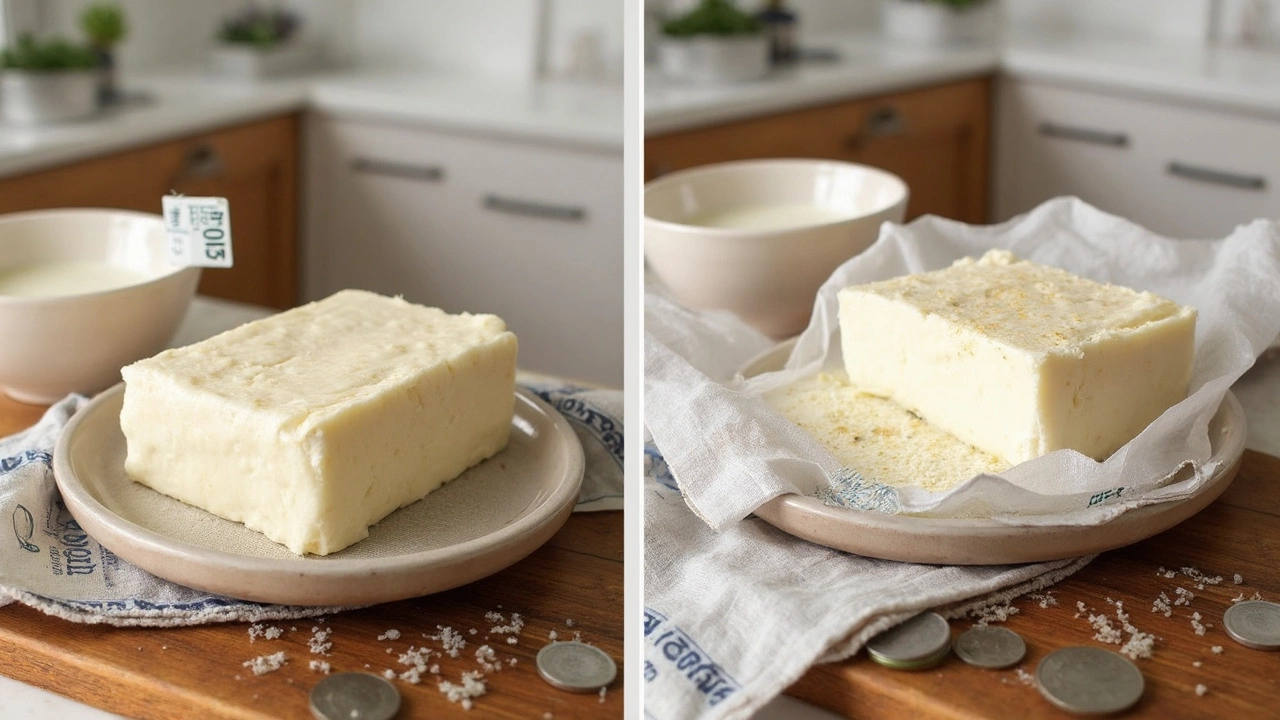28 May 2025
- 0 Comments
Paying nearly triple for a tiny block of paneer at the supermarket? It feels like some kind of joke—especially once you realize that making paneer at home is just a matter of boiling milk and adding an acid. But is it actually cheaper, or is that just a nice story food bloggers tell?
No guesswork here—let’s look at real numbers. To make 200 grams of fresh paneer, you’ll need about a liter of full-fat milk. In most cities, that’s going to cost you less than buying the same amount of pre-packed paneer. Sure, there’s a little bit of effort, but you get fresh, soft results and total control over what goes in. Most people are surprised at how simple and hands-on the process is, and how quickly they can get the hang of it after one messy first attempt.
Homemade paneer comes with an extra bonus: way fewer additives and no weird preservatives. You can even use organic milk if you want. The best part? You can use the leftover whey in soups or to knead dough, so nothing goes to waste. If you’re making curries, kebabs, or just love snacking on paneer straight from the fridge, going homemade packs value in more ways than just money.
- The Real Cost of Homemade Paneer
- How Store-Bought Compares
- Tips for Cutting Down Costs
- Is Making Paneer Worth Your Time and Money?
The Real Cost of Homemade Paneer
If you’ve ever been curious about the actual cost breakdown, here’s the lowdown. To get around 200 grams of homemade paneer, you’ll need about one liter of full-fat cow’s milk. In India, one liter of good milk usually costs between 50 to 65 INR. If you’re somewhere like the US, expect to pay between $1.00 and $1.50 for a similar amount, depending on whether you pick organic, regular, or local dairy options.
Your main extra is a souring agent—like lemon juice or vinegar. The cost for a tablespoon of lemon juice? Basically a couple of rupees or a dime. You don’t need anything fancy, so even basic white vinegar does the trick.
Let’s break it down:
- 1 liter milk: 50-65 INR ($1.00-$1.50)
- 1-2 tablespoons lemon juice or vinegar: 2-5 INR (under $0.10)
Total: Around 52-70 INR or $1.00-$1.60 for a 200g batch of paneer. At most supermarkets, that much paneer easily sets you back 90-130 INR, or about $2.50-$3 in the US for a branded version.
Equipment-wise, you probably already have what you need: a pot, a strainer, and a clean cloth or muslin. No need to buy anything special or invest in gadgets. The milk-to-paneer ratio is about 1:5, so don’t be shocked if a liter of milk turns into a small, dense chunk—it’s normal, and that’s how fresh paneer works.
One bonus: no delivery fees, no questionable preservatives, and you get to keep the leftover whey. That stuff is quietly awesome for soups, rotis, and smoothies. If you’re cooking for a family, doubling or tripling the batch only multiplies the savings, since the main expense—milk—usually comes cheaper in bulk.
How Store-Bought Compares
Walking down the dairy aisle, you’ll see stacks of paneer in all sorts of packaging—vacuum-sealed, sliced, or even “low-fat.” The easy part about store-bought paneer is that there’s zero prep time. Just open the pack and toss it into your recipe. But let’s talk about the numbers, the ingredients, and what you’re actually getting.
Big brands like Amul, Mother Dairy, and local dairy shops usually price paneer by the 200-gram or 400-gram pack. In 2025, here’s what you’ll typically see in an average Indian grocery store:
| Product | Pack Size | Average Price (INR) | Ingredients |
|---|---|---|---|
| Amul Paneer | 200g | ₹90-110 | Milk solids, acidity regulator |
| Mother Dairy Paneer | 200g | ₹85-100 | Milk, citric acid |
| Local Dairy Paneer | 200g | ₹65-90 | Milk, lemon or vinegar |
When you check the label, there’s always a long shelf life—sometimes up to ten days, thanks to preservatives or vacuum-packing. If you’ve ever noticed a rubbery texture or bland flavor, that’s usually why. While store-bought paneer wins on convenience, it can lose points on taste and freshness. And if you add up costs for a family who cooks with paneer twice a week, that’s ₹400 or more per month just for this one food!
Another thing: store-bought paneer usually comes from toned or skimmed milk, so it sometimes turns dry when cooked (especially in high-heat dishes like paneer tikka). Many people end up adding extra cream to recipes to compensate, which is an extra cost and extra calories. If you’ve got kids or care about clean eating, you might not love the long list of stabilizers on some brands either.
So when you’ve got time and want the best bang for your buck, homemade is often the top choice. If you need dinner done in ten minutes or just want to grab and go, store-bought paneer still wins for ease. But homemade paneer usually gets the crown for freshness, taste, and value for money.

Tips for Cutting Down Costs
If you're looking to make homemade paneer for less, a few smart choices can help keep those prices down without sacrificing quality. Here’s how:
- Buy milk in bulk. Larger packs or containers usually cost less per liter. If you're making paneer often, this adds up fast. Supermarkets and wholesale stores sometimes run deals on full-fat milk, so keep your eyes open.
- Pick regular full-fat milk over fancy brands. As long as it's not UHT (ultra-pasteurized), even regular store-brand milk works. Save the organic stuff for when you want a treat.
- Use lemon juice or plain white vinegar as your acid. Skip expensive specialty acids—they won’t make a big difference to taste or texture.
- Don’t toss the leftover whey. Use it in curries, for kneading chapati dough, or even to cook rice. Every bit you reuse stretches your money further and adds a protein boost to your meals.
- Make bigger batches if you know you'll use it. Paneer stays good in the fridge for up to five days, and you can freeze it in a pinch. The more you make at once, the more you save on fuel and effort per portion.
Look at the difference in average costs based on 2025 prices:
| Item | Homemade Paneer (per 200g) | Store-Bought Paneer (per 200g) |
|---|---|---|
| Milk | $1.05 | - |
| Lemon/Vinegar | $0.10 | - |
| Total Homemade | $1.15 | - |
| Packaged Paneer | - | $2.90 |
One final tip: skip pre-boiled or pre-packaged milk if you can. Fresh milk yields a firmer and tastier paneer, giving you better texture for less money. When it comes to stretching your kitchen budget, making your own homemade paneer wins out almost every time.
Is Making Paneer Worth Your Time and Money?
Let’s get to the real question everyone has: does making paneer at home really save your wallet, or is it just a kitchen project for weekends? First, let’s nail down the exact numbers comparing homemade and store-bought homemade paneer in terms of both money and effort.
| Homemade Paneer (200g) | Store-Bought Paneer (200g) | |
|---|---|---|
| Milk/Paneer Cost | $1.10 (1L whole milk) | $2.80 (average urban market) |
| Other Ingredients | $0.10 (lemon/vinegar) | — |
| Time Spent | ~30 minutes (hands-on: 10-15 mins) | 2-5 minutes (just shopping) |
| Additives/Preservatives | None (unless you add) | Common in pre-packed |
| Possible Waste | Whey (can be reused) | Plastic packaging |
If you buy a few liters of milk at a time or use local dairy, the cost per 200g can dip even lower. And while you’ll spend about 30 minutes total, only half that needs your attention—the rest is just draining and pressing. For a family that eats paneer regularly, those dollars add up over the months. Even with premium, organic store-bought brands (sometimes going up to $4 for 200g), the gap gets even wider.
The big trade-off is really time versus convenience. If you’re rushing after work, store-bought has your back. But if you value knowing what’s going in, cutting down on plastic, or saving on your grocery bill, homemade is the clear winner. Lots of home cooks batch-make paneer and freeze what they don’t need that week—so you don’t have to start from scratch every time.
- Use the leftover whey as soup stock, in smoothies, or for kneading dough.
- Try making a bigger batch and freezing in portions – homemade freezes well for about a month.
- If milk is pricey in your area, find a local dairy. Bulk milk almost always works out cheaper.
So, if you eat paneer now and then, you might not notice a dramatic difference. But if it’s a weekly staple (trust me, it happens fast), there are clear savings. Plus, let’s admit it—the texture and taste of fresh paneer are tough to beat.
